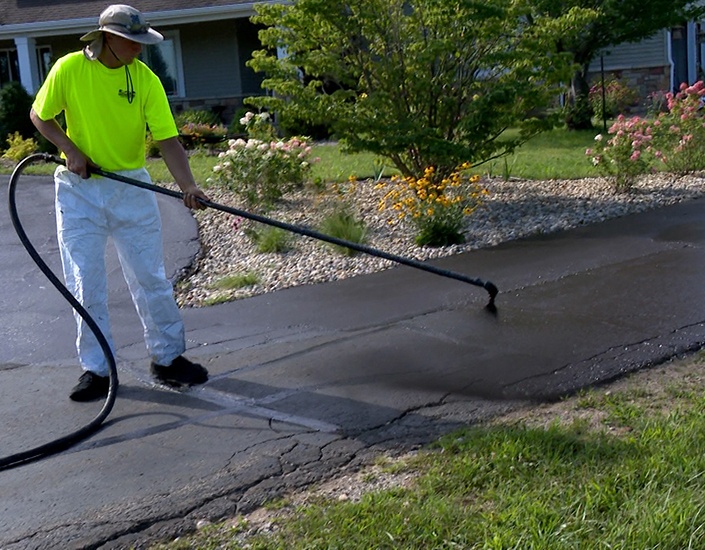Optimize Toughness: Warm Mix Asphalt Sealing for Angled Parking Frameworks
Optimize Toughness: Warm Mix Asphalt Sealing for Angled Parking Frameworks
Blog Article
Warm Mix Asphalt: A Lasting Option for Sidewalk
Hot Mix Asphalt (HMA) has become a leading lasting choice for pavement services, using a myriad of ecological advantages and ingenious modern technologies. Its capability to decrease and reuse products power consumption presents an engaging situation for its fostering in roadway building projects. Moreover, the lasting efficiency and resilience of HMA make it a preferred option for facilities growth. As the need for eco-friendly building techniques grows, exploring the nuances of HMA's sustainability can offer useful understandings into the future of sidewalk remedies.
Environmental Benefits of Hot Mix Asphalt

In Addition, Hot Mix Asphalt helps to minimize city warm island effects. Its dark color takes in sunshine, reducing the amount of warm mirrored back into the ambience contrasted to lighter-colored pavements. This can reduce ambient temperature levels in urban locations, decreasing the demand for cooling and inevitably lowering energy usage.
In addition, Hot Mix Asphalt contributes to enhanced stormwater management. Its porous nature allows water to infiltrate the pavement and charge groundwater materials, minimizing overflow and the threat of flooding. These ecological advantages make Warm Mix Asphalt a sustainable selection for leading roads and freeways.
Power Performance in HMA Production
Is energy effectiveness a critical factor in the production of Warm Mix Asphalt (HMA)? Absolutely. Power plays a significant duty in the production of HMA, affecting both cost and environmental sustainability. One essential element of power performance in HMA manufacturing is making use of warm mix asphalt (WMA) innovations (commercial parking lot paving). WMA permits the blending and positioning of asphalt at lower temperatures contrasted to standard hot mix asphalt, resulting in minimized power consumption during manufacturing. This process not only lowers gas usage but likewise reduces greenhouse gas exhausts, making it a much more eco-friendly alternative.
In addition, improvements in plant modern technologies have brought about more energy-efficient HMA manufacturing procedures. Modern plants are developed with functions like recycled asphalt sidewalk (RAP) processing abilities, reliable heater systems, and enhanced insulation, all contributing to power cost savings. By maximizing power use in HMA production, the sector can minimize its carbon impact while maintaining top quality pavement materials. Energy effectiveness is, as a result, a vital factor to consider in guaranteeing the sustainability of Hot Mix Asphalt production.
Recyclability of Hot Mix Asphalt
The recyclability of Hot Mix Asphalt (HMA) is an essential element of its sustainability and long-term environmental influence. HMA is one of one of the most recycled materials in the United States, with over 100 million lots of reclaimed asphalt pavement (RAP) being reused yearly in new pavement building and construction. Recycling HMA uses a number of environmental benefits, such as decreasing the demand for virgin products, reducing energy consumption during manufacturing, and lowering the amount of waste sent to land fills.
The procedure of reusing HMA involves milling the existing sidewalk, crushing it into smaller sized items, and blending it with new accumulation and asphalt binder to produce a recycled mix. Overall, the recyclability of HMA plays a substantial function in advertising lasting techniques within the pavement sector.

Long-Term Performance of HMA
Asphalt sidewalks show resilience and durability over a prolonged duration, mirroring the long-term efficiency of Hot Mix Asphalt (HMA) Additionally, improvements in HMA modern technology, such as the usage of polymer-modified binders and warm mix asphalt, have actually better boosted the resilience and longevity of HMA pavements. By prioritizing top quality construction and maintenance techniques, HMA continues to show itself as a economical and lasting solution for durable sidewalk facilities.

HMA: Sturdiness and Sustainability
Demonstrating both sturdiness and sustainability, Warm Mix Asphalt (HMA) has actually become a keystone in the building of resilient sidewalk infrastructures - angled parking. HMA's longevity stems from its ability to hold up against heavy loads, severe climate condition, and high traffic volumes, making it a trustworthy choice for highways, freeways, and airport runways. The structure of HMA, which normally consists of accumulations, binder, and filler, plays an important role in improving its durability and resistance to tear and wear
Furthermore, HMA's sustainability exists in its recyclability and energy-efficient production process. The ability to reuse redeemed asphalt sidewalk (RAP) in brand-new HMA mixtures decreases the need regrading for virgin products and decreases the ecological effect of sidewalk building and construction and upkeep. Additionally, the energy effectiveness of creating HMA hinges on its lower mixing temperature levels contrasted to various other sidewalk products, causing minimized power usage and greenhouse gas discharges.
Verdict
In final thought, hot mix asphalt (HMA) uses a sustainable service for pavement with its eco pleasant characteristics. HMA's recyclability, power efficiency in production, and lasting resilience make it a green option for road building and construction.
HMA is one of the most recycled materials in the United States, with over 100 million loads of redeemed asphalt pavement (RAP) being recycled yearly in new pavement building and construction.The process of recycling HMA includes milling the existing pavement, squashing it into smaller sized pieces, and blending it with brand-new aggregate and asphalt binder to produce a recycled mix.Asphalt pavements show resilience and durability over an extensive duration, showing the lasting performance of Hot Mix Asphalt (HMA) Additionally, innovations in HMA technology, such as the use of polymer-modified binders and warm mix asphalt, have even more enhanced the toughness and longevity of HMA pavements. The capacity to recycle reclaimed asphalt pavement (RAP) in brand-new HMA mixtures decreases the demand for virgin products and lessens the ecological impact of pavement building and construction and maintenance.
Report this page